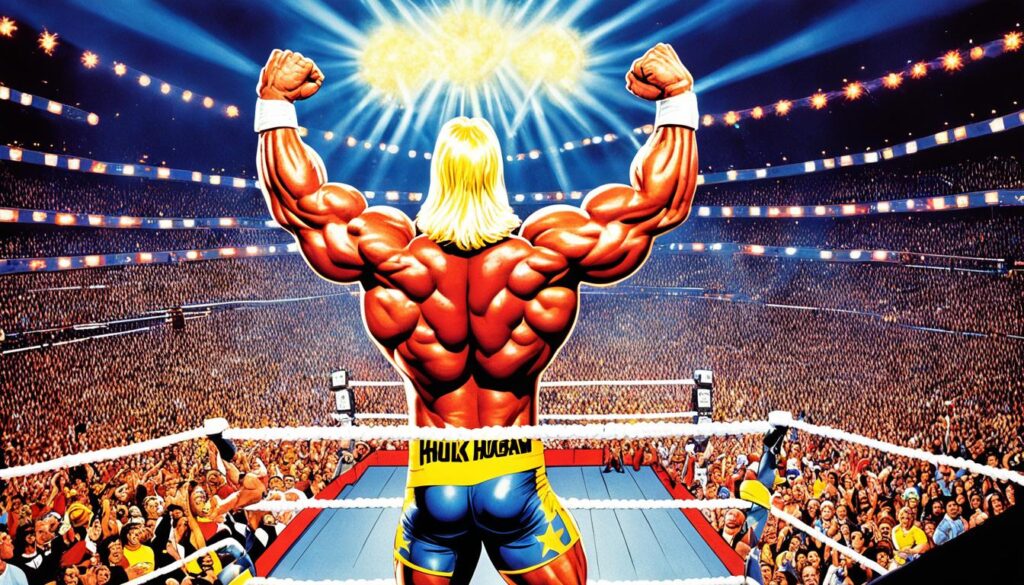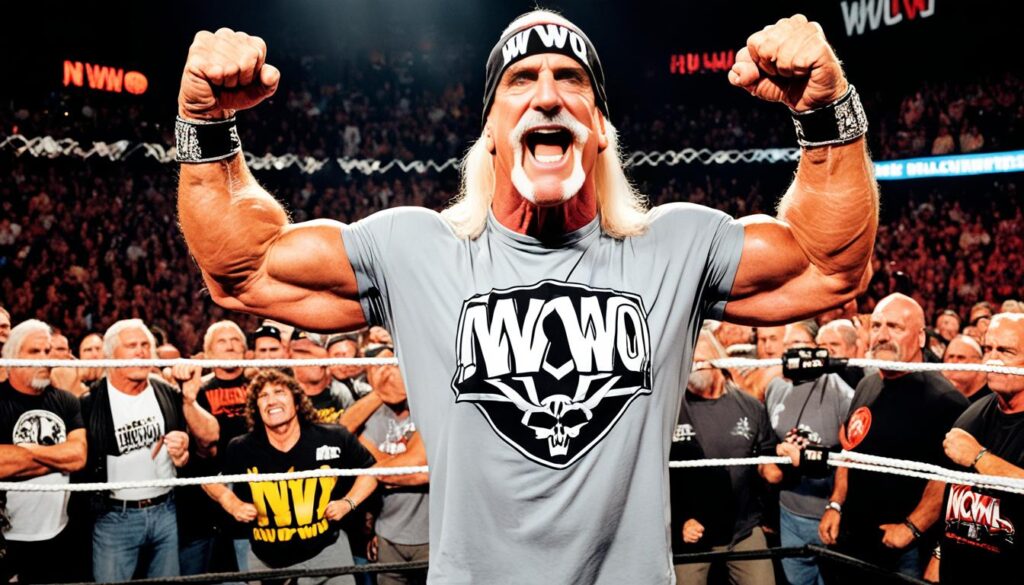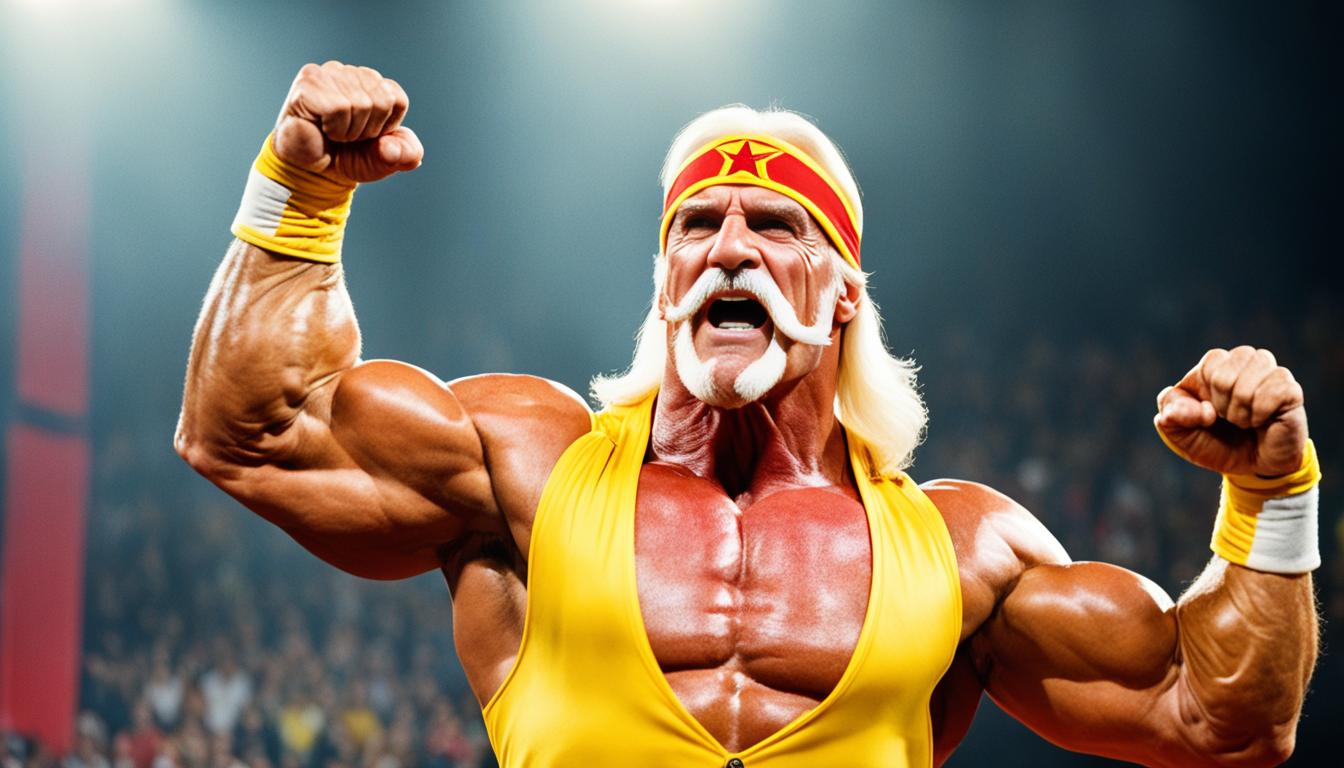Hulk Hogan, whose real name is Terry Gene Bollea, is a prominent figure in the world of professional wrestling. Hogan played a significant role in popularizing wrestling during the 1980s and beyond. With his charisma, Hogan rose to fame as a pop culture icon.
Hogan’s journey began in a small wrestling promotion in the late ’70s. He started in 1977, winning fans over with his charm and athleticism. This young wrestler was on his way to becoming a legend.
In December 1983, Hogan joined the World Wrestling Federation (WWF). He quickly became a star. Hogan headlined WrestleMania eight times, thrilling millions of viewers.
As a champion, Hogan won the WWF Championship five times. His longest reign lasted 1,474 days. Hogan also made history at the Royal Rumble, winning it back-to-back in 1990 and 1991.
Hogan’s fame soared with his 1988 match against Andre the Giant. The match earned a 15.2 Nielsen rating and 33 million viewers. It made Hogan a household name.
In 1994, Hogan signed with World Championship Wrestling (WCW). He dominated there as well. Hogan won the WCW World Heavyweight Championship six times.
Hogan headlined WCW’s Starrcade in 1994, 1996, and 1997. His performances were unforgettable, captivating fans everywhere.
After a break, Hogan returned to the WWF in 2002. He won the Undisputed WWF Championship. Hogan was inducted into the WWE Hall of Fame in 2005 and 2020 with the nWo.
Hogan’s impact continues today. He connects with fans on social media and inspires many. Hogan remains influential through his autobiography, action figures, and music videos.
Key Takeaways:
- Hulk Hogan is a wrestling icon with a career that spans decades.
- He achieved immense popularity as a key figure in the World Wrestling Federation (WWF) and World Championship Wrestling (WCW).
- Hogan held multiple world championship titles and set records for his impressive reigns.
- His charismatic personality and larger-than-life persona made him a household name and a pop culture legend.
- Hogan’s legacy continues to inspire and entertain fans today through various mediums.
Early Life and Training
Hulk Hogan, born as Terry Gene Bollea on August 11, 1953, came from humble beginnings. He moved to Port Tampa, Florida, as a boy. Here, he started his journey to become a wrestling legend.
He first stepped into the ring in Championship Wrestling from Florida in August 1977. Wrestling as the Super Destroyer, Hogan caught everyone’s eye quickly. Fans and insiders alike noticed his talent.
In 1979, Vince McMahon Sr., the WWE owner, saw Hogan’s potential. This was a huge turning point for Hogan. McMahon convinced him to join WWE, leading to Hogan’s rise to fame.
Hogan’s trainer was the great Hiro Matsuda. Matsuda was key in shaping Hogan into the superstar he became. He taught Hogan the skills needed to captivate the world.
The training was hard, but Hogan was determined. After a break, he returned to wrestling with more passion. In December 1979, he won the NWA Southeastern Heavyweight Title, beating Dick Slater.
Hogan overcame many hurdles early on, including low pay and personal issues. Yet, he never stopped pushing forward, thanks to his strong determination.
Rise to Prominence in the WWF
When Hulk Hogan joined the WWF (now WWE) in 1983, he was about to change wrestling forever. He quickly became a favorite, thanks to his charisma and strong presence. This period is known as professional wrestling’s “Golden Era.”
Hogan’s big break came with his win against the Iron Sheik in 1984. This victory gave him the WWF Championship. It was a special moment that made Hogan a household name.
In 1987, Hogan fought Andre the Giant at WrestleMania III. The battle was in Detroit before 90,000 fans. It proved how popular Hogan had become.
Hogan also shone outside the ring. He appeared on MTV’s “Saturday Night Live” and starred in “Hogan Knows Best” on VH1. This show broke TV ratings records.
Hogan was the main event at the first three WrestleManias. He fought “Rowdy” Roddy Piper and King Kong Bundy among others. These matches are legendary in WWE lore.
His notable battles include facing Andre the Giant and Randy Savage. His clash with The Rock at WrestleMania X8 is also unforgettable.

The image above shows Hogan’s iconic match at WrestleMania III against Andre the Giant. This moment is legendary in wrestling history.
Even when Hogan wasn’t in WWE, fans missed him. His return in 2002 for WrestleMania 30 and his 61st birthday on Raw was highly celebrated.
Hogan’s effect on the WWF during the Golden Era was monumental. He won over fans with his energy, skill, and connection with the audience. Hogan truly is a wrestling icon.
NWO and WCW Success
In 1993, Hulk Hogan left WWF and made a big splash by joining WCW (World Championship Wrestling) in 1994. His arrival kicked off a new era and led to a wrestling boom. This boom transformed the industry.
At Bash at the Beach in June 1994, Hogan debuted in WCW by defeating Ric Flair. He won the WCW Championship. This win not only boosted his reputation but also hinted at a new direction for his character.
In July 1996, Hogan shocked fans again at Bash at the Beach. He turned heel, joining Scott Hall and Kevin Nash to form the New World Order (nWo). This move gave birth to Hollywood Hogan, changing wrestling’s landscape forever.
The nWo quickly rose to fame as one of wrestling’s most powerful factions. Hogan led them, bringing a new rebel vibe to the scene. Their popularity helped WCW compete in the Monday Night Wars against WWF.
Hogan won the WCW World Heavyweight Championship six times during his time at WCW. His matches and storylines thrilled fans globally, playing a huge part in WCW’s success.
But, Hogan’s WCW glory days came to an end at Starrcade 1997. He lost the WCW title to Sting. This match was a career turning point and hinted at WCW’s decline.>
Hogan’s final WCW appearance was at Bash at the Beach in 2000, wrapping up his time there. Despite the highs and lows, his influence on wrestling during this period is undeniable.

Hulk Hogan’s stint in WCW and with the nWo is a landmark in wrestling history. His transformation into Hollywood Hogan and forming the nWcha changed his career. It took his legacy to new levels of fame.
Next, we’ll look at Hogan’s WWE return and his ongoing impact on wrestling.
Conclusion
Hulk Hogan is a wrestling icon whose career will always be remembered. His start in Florida led to fame in the WWF and WCW. Hogan’s charisma and talent made him a star.
He achieved amazing milestones throughout his career. Hogan held the WWF/E Championship multiple times, with his first reign lasting over four years from 1984 to 1988. His victories in the 1980s and 1990s won fans globally.
At WrestleMania III in 1987, Hogan’s victory against Andre The Giant was monumental. It was in front of a massive audience. This match highlighted Hogan’s strength, charm, and appeal.
Hogan’s legacy goes beyond wrestling. He became a pop culture icon and a familiar face in sports. Fans all over the world still admire him.
To sum up, Hulk Hogan’s career has been remarkable. With unforgettable matches, significant records, and legendary status, his impact lasts. His work in wrestling is celebrated by fans across generations.








